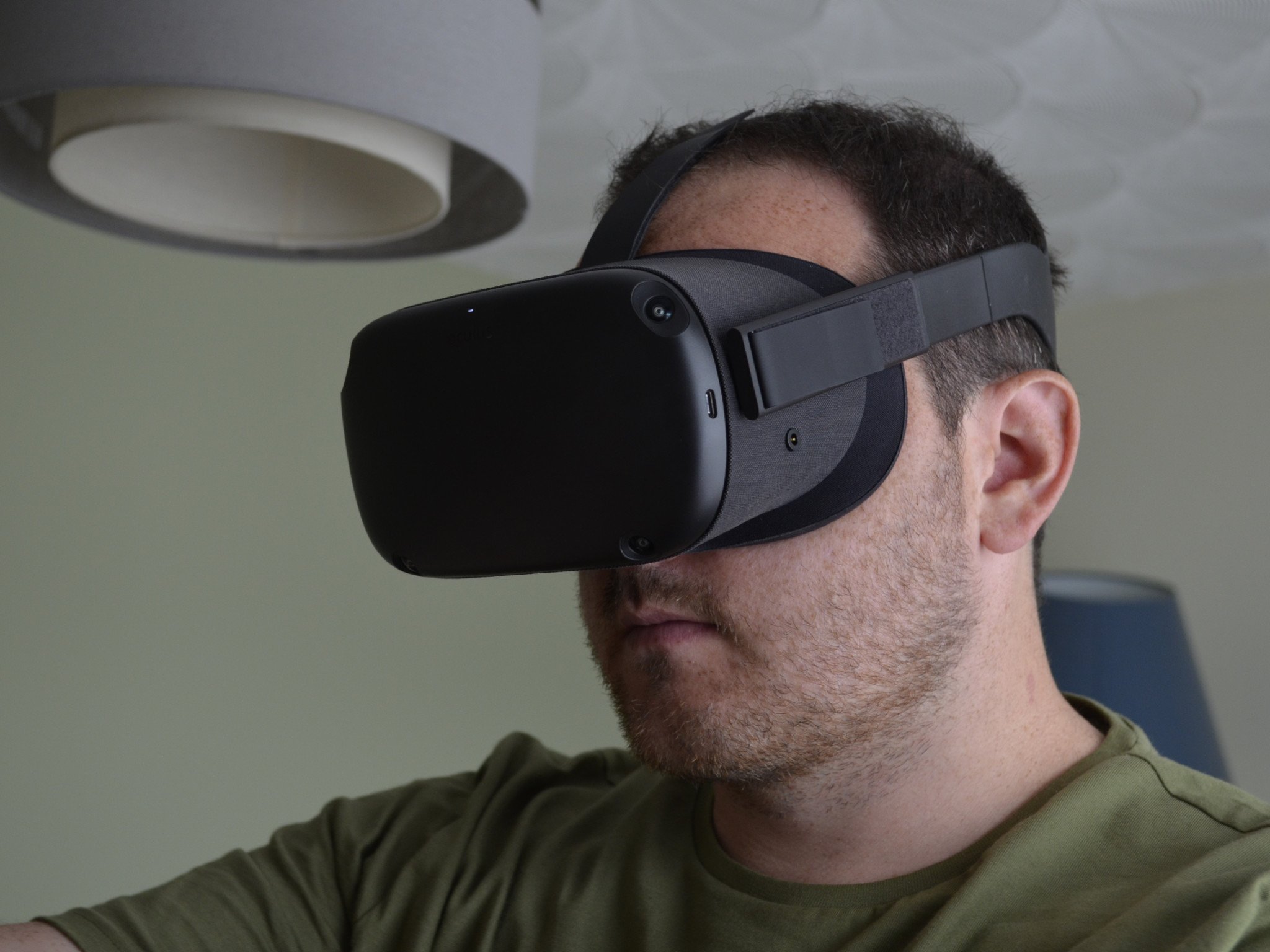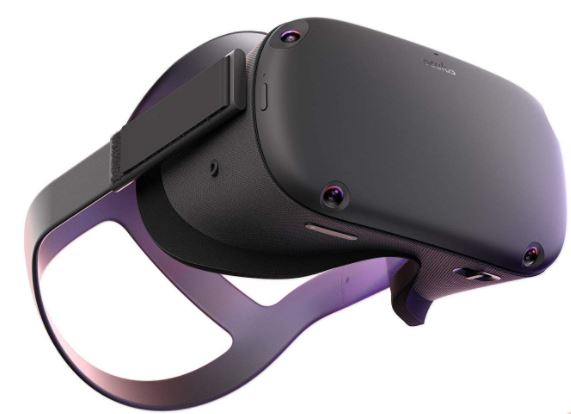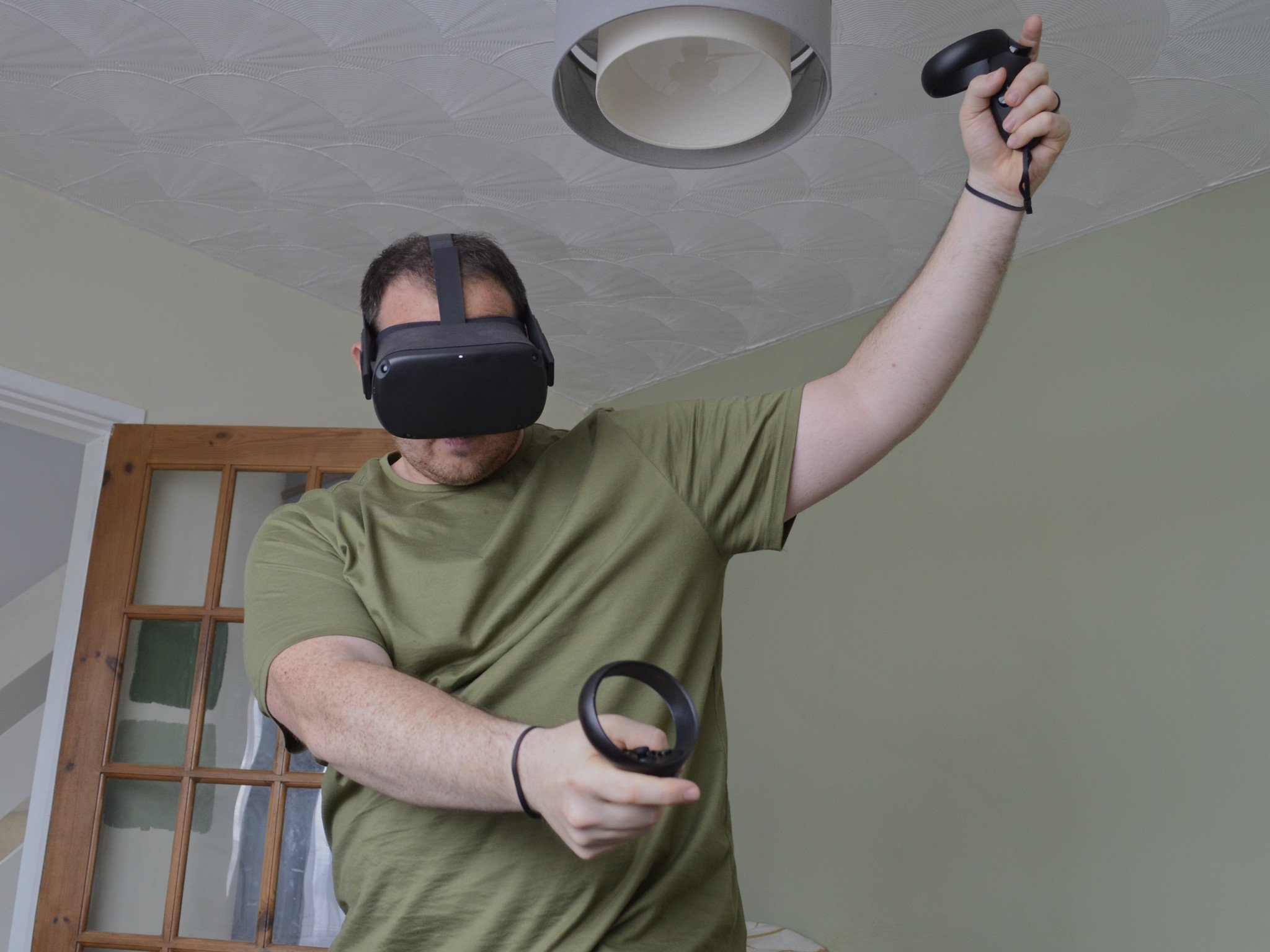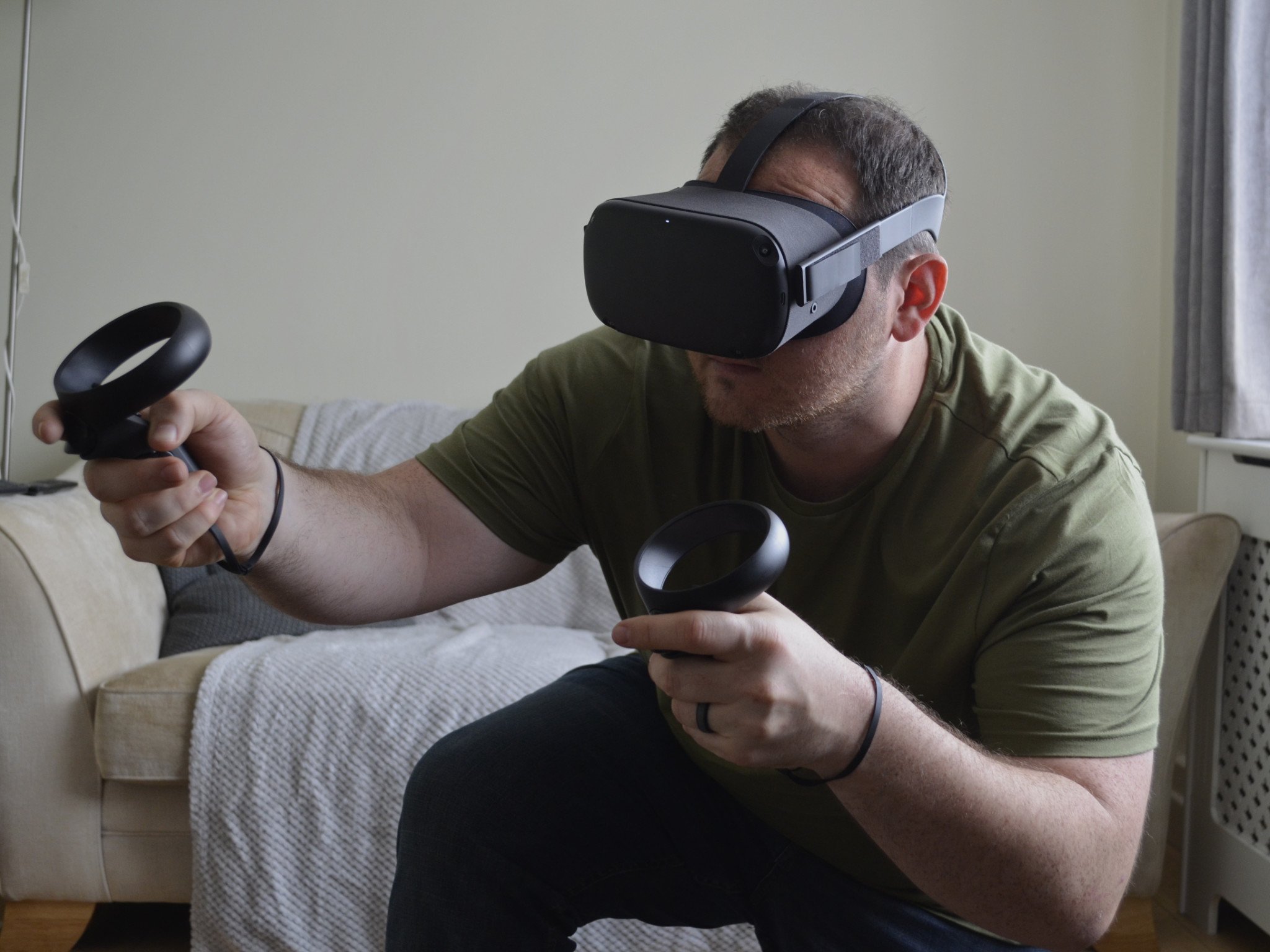The Oculus Quest builds from lessons learned from mobile VR efforts such as the Oculus Go and blends them with power and fidelity to deliver a one-of-a-kind VR experience. The Oculus Quest is an immersive VR device that users can get blissfully lost in due to its lack of wires or external sensors.
Because Oculus has been a main contender in the VR space for many years, an impressive library of titles was available at the launch of the Oculus Quest. Both the makers of the Oculus Quest and the makers of its games and apps have clearly spent years crafting and refining this virtual reality experience. It's intuitive, easy to learn, and can take over a party in a way we haven't seen since the likes of Dance Dance Revolution and the Wii.
The Oculus Quest has two different variants, the only difference being storage size. The 64GB version costs $399, and the 128GB version costs $499. The 64GB version is ideal for the average user. Unless you're an extremely avid gamer who is going to have a massive library of games or a heavy media user who plans to store loads of large movie files on your Oculus Quest, you shouldn't need the 128GB version.
Oculus Quest 64GB vs. Oculus Quest 128GB: Which should you buy?
Whether you're a veteran of VR or a newcomer, the Oculus Quest provides something uniquely different to anything you've tried before.
Untethered VR
Oculus Quest
Untethered VR
The Oculus Quest creates an immersive virtual reality that allows you to dive into games and media without any external sensors or wires. Its support of popular titles and its portability make it an ideal VR headset for use at home or on the go.
Pros:
- Doesn't require any external hardware like a PC or phone.
- Runs completely wirelessly.
- Impressive tracking with support for Six Degrees of Freedom.
- Supports two Touch Controllers for immersive gameplay.
Cons:
- Doesn't support Bluetooth headphones.
- Noticeably leaks light around the nose area.
Oculus Quest How it does VR right
The Oculus Quest features a refined design that builds on the already impressive Oculus Rift and Oculus Go. The details and design of the headset clearly illustrate that Facebook has learned from their experience in VR. From the overall design of the headset to the small details that enhance the fit and level of immersion, the hardware of the Oculus Quest is thoughtful and functional.
The body of the headset has a fabric exterior and a matte black plastic front. This front panel houses the four built-in cameras that are the core of the Oculus Quest's inside-out tracking system. They map out the room you're in and also keep track of a pair of Touch Controllers that you use to interact with games and apps. These cameras make it so you don't have to use any external sensors when using the Oculus Quest. You don't need to set up any towers or dedicate a specific room to VR. As a result, you can take the Quest with you to most rooms or to a party.
Despite not requiring any external hardware or sensors, the Oculus Quest can still track your movements with Six Degrees of Freedom. In essence, it can track you as you walk around a room, moving up, down, left, right forward, and backward; it opens a whole new world when it comes to mobile virtual reality.
When you enter any environment and put on the Oculus Quest, it will have you draw a boundary for your VR area. This is part of the Guardian tracking system that sets up a virtual grid to make sure you don't bump into anything or punch a TV, both serious risks when dealing with VR. Drawing an area is simple, and the grid disappears if you aren't near a boundary and pops up if you are. If you stick your head outside of the drawn boundaries the Quest's passthrough cameras will show you the real world without you having to remove the headset.
After you map a room, the Oculus Quest will remember that room in the future, though the Quest can only store a few rooms right now. I also noticed that my Oculus Quest only seems to save the mapping of a room if I walk in and face a certain way. I'd like to see the Oculus Quest improve how it stores and recognizes areas that you've previously mapped.
The Oculus Guardian system is an essential part of the Quest. The headset is so portable that you need to be able to draw boundaries quickly and reliably. SUPERHOT VR requires you to twist, turn, and duck to dodge bullets and fight enemies in slow motion. It's an incredible game that's only made better by the immersion provided by the Oculus Quest. When I'm deep into that game, I often forget where I am in the real world. I've taken the headset off to realize that I'm facing an entirely different way than I thought. The Oculus Quest's Guardian system means I can focus on the games I'm playing and trust that I'm not going to run into a wall. The device can't track who or what walks into the room though, so be careful who else is nearby when you're playing. I accidentally hit my dog while playing Robo Recall: Unplugged. He's fine, albeit confused by the concept of VR.
The Oculus Quest's battery life lasts between two and three hours, depending on what you're doing. I've found that the device is comfortable enough that I could wear it for extended sessions and worry about battery life before dealing with discomfort. The foam padding on the inside of the device cushions the headset against your forehead and cheekbones. The Quest has a cradle of silicone straps with a strap on each side of the headset and one that goes over your head. These meet up around the back in a rounded triangle that balances the headset and distributes weight across your head. The Velcro straps are easy to adjust, and the padding keeps any pressure off of my face. I've seen people online complain about pressure on their cheekbones, with some resorting to using a battery pack to change the balance of the headset and to relieve pressure from their face. While I don't think I need this, it's a common enough complaint that it's worth bringing up.
From the first moment that I booted up the Oculus Quest, I felt like this is how virtual reality was always supposed to be.
Facebook did a great job when focusing on little things to improve the feeling of immersion with the Oculus Quest. The lenses of the Quest can be adjusted with a slider depending on how wide apart your pupils are. When I took the Quest to a family get together, one relative mentioned that everything seemed blurry. We quickly adjusted the slider to his eye width, and he felt completely immersed.
Another smaller detail is that the Oculus Quest has two headphone jacks. This is so you can use headphones like Oculus' official Quest headphones that have each headphone plug in separately to reduce the number of wires you need to use headphones. The Oculus Quest does not support Bluetooth headphones, so you'll have to use wired ones or the headset's built-in speakers.
I was surprised to see that many reviewers and early adopters of the Oculus Quest were negative on the headset's speakers. I've found them to be quite impressive. They're not going to replace a pair of Bose QC35s, but they support spacial audio which is essential for games like Vader Immortal: Episode I and Robo Recall: Unplugged that have enemies appear around and behind you. Using the Quest's speakers, I'm able to identify where an enemy is and turn before I get hit. They also work well with games like Beat Saber, which relies on music. It's worth noting that a firmware update that came out before the Oculus Quest shipped to the public seems to have improved audio. One of our writers couldn't get the firmware update on his Oculus Quest until a day or two after receiving the headset and noted a significant difference in audio quality before and after the firmware update.
The Oculus Quest supports two Touch Controllers. These will look familiar to anyone who has used the Oculus Rift, though there are some slight design changes for the Quest version. These Touch Controllers have a plethora of buttons that seemed intimidating at first. On the top of each controller there are two buttons for gameplay, a joystick, and a home button. Each controller also has a grip button and a trigger button on the back. I was initially worried about using a pair of controllers with so many inputs, but they're mapped well and have a very small learning curve.
In addition to all of the buttons on the Touch Controllers, the Oculus Quest also tracks the controllers' movements and tilt. This is where the Oculus Quest shines. Even though there are no external sensors or cameras, tracking on the Touch Controllers is great. I've been swinging at blocks in Beat Saber, shooting and stabbing enemies in SUPERHOT VR, and jumping in and out of several games and apps every day and have rarely run into any issues. The only time my Touch Controllers have had issues is if I hold them extremely close to my face or I'm in very bright sunlight. The Oculus Quest isn't meant for outdoor use so bright lights shouldn't be a problem that often. I do lose tracking when I'm next to a bright window, so I occasionally have to shut curtains.
Combined, this hardware adds up to an incredible experience. From the first moment that I booted up the Oculus Quest, I felt like this is how virtual reality was always supposed to be. Even picking up blocks and paper airplanes in the welcome area of the Quest felt natural. As I dive deeper into games, I've been increasingly impressed with the Quest's hardware and software working together to make me feel like I'm in my own world.
This intuitive nature extends into gaming thanks to developers taking advantage of the Quest's various cameras and sensors. In Robo Recall: Unplugged, you reach down to your hip to grab guns from virtual holsters and grab shotguns by reaching over your shoulder. I felt like there was no learning curve at all for just about every game I tried. Vader Immortal: Episode I is another example of a game that just feels right. Even in the training dojo, you jump right in. Reflecting lasers at robots and droids happens naturally, and after only a few sessions in the game, I caught myself doing maneuvers by reflex.
While the Oculus Quest is best for gaming, at least in my opinion. It can also be used for enjoying media. You can watch 2-D, 3-D, and 360 videos inside of the device. You can also stream content from YouTube, Netflix, and other services. I personally don't use the Oculus Quest for this that often, but it is nice to have the option to view content on a giant virtual screen.
Oculus Quest Impressive but not quite flawless
The Oculus Quest is an incredible combination of hardware and software, but it has some flaws. These are minor in the grand scheme of things, in my opinion, but there are some things I wish were different.
First, the Oculus Quest doesn't support Bluetooth headphones. It's odd that a device so clearly marketed as an untethered VR headset requires wires if you want to use headphones. I understand that this is a technical challenge. John Carmack, the CTO of Oculus VR, said that latency issues were still present with the Quest which is why Bluetooth headphones aren't supported. I'm glad that they've addressed it directly, but I'd be happier if Bluetooth headphones were supported.
No, the added latency is still a problem.
— John Carmack (@ID_AA_Carmack) April 22, 2019
Second, The Oculus Quest also has noticeable light leak around the nose of the headset. If you're playing a darker game or focus on it, it's easy to see a lot of light seeping through the bottom of the headset. I'm not sure why there's such a large gap. I don't exactly have a small nose, and there is still a significant gap for me. I can fit a finger around my nose in every direction while wearing the headset. I've heard people say this helps them orient themselves by looking through the bottom of the headset, but I don't use a VR headset that's marketed towards being immersive to be able to orient myself by looking through a nose hole. I often forget that it's there, but there are times that it's more noticeable than others. I hope someone comes out with a facemask or add-on that can close this gap.
Is this virtual reality's iPhone moment?
The buzz on the web around the Oculus Quest often includes people asking if the release of the Oculus Quest is virtual reality's iPhone moment. Meeting that threshold would be quite the feat. While the iPhone was not the first smartphone, it was arguably the first smartphone the masses cared about. It brought smartphones into the mainstream and drastically rewrote the path of mobile computing. In fact, the iPhone was so impactful that it didn't just alter how the world views phones; it affected tablets, wearables, and computing as a whole.
I'm not sure if historians will look back at the release of the Oculus Quest as the iPhone moment for VR. I'm not sure that any single device will ever be as impactful as the iPhone. But that doesn't mean the Oculus Quest isn't an excellent headset. I think it's more comparable to a different device, the Nintendo Wii.
It appeals to gamers, casual users, and people who never saw themselves using a VR headset.
The Nintendo Wii didn't stack up graphically to its competitors. What it did do was create a unique style of gameplay that was infectious. Everyone from kids to retirees in old folks homes played the Wii. Its minimal learning curve and reliance on movement rather than buttons and traditional controllers delivered gaming to generations and audiences that other consoles couldn't.
I view the Oculus Quest in this vein. It's so easy to hand to someone who doesn't know anything about video games or VR and get them playing in moments. It's a blast at parties and family events, and I've already had family members ask how much it costs and joke about me leaving it with them to take care of for a while.
Unlike underpowered devices like the Oculus Go, the Oculus Quest can play popular titles and handle relatively demanding games. There are some titles available on the Oculus Rift that won't make their way to the Quest, but the library of available games is impressive. Sports Scramble is reminiscent of Wii Sports. Vader Immortal: Episode I is what I dreamed of when I swung around a glowing lightsaber while dressed up as Darth Vader for Halloween. Beat Saber is a game that can be played at the most basic skill level or be taken to the extreme for hardcore gamers. The Oculus Quest is an immersive and versatile VR headset. It appeals to gamers, casual users, and people who never saw themselves using a VR headset.
Oculus Quest hands-on: A headset for those who didn't know they cared about VR
Even if the Oculus Quest isn't comparable to the iPhone, it would still be a success if it ever was viewed in a similar light to the Wii. The Wii is one of the five highest selling consoles of all time and was so unique that it pushed Microsoft and Sony to try to copy it. If the Oculus Quest is remembered for being the first VR device to convert non-VR users, then it will hold a respectable spot in history.
Oculus Quest Should you buy it?
The Oculus Quest is unique in that it delivers high-quality VR gaming without needing any external sensors, cameras, or wires. Its refined design and immersive interface are worth the $399 price tag you'll have to spend for the 64GB version. No device on the market will provide the same level of portability and quality of gaming within the same headset.
The Oculus Quest is also an all-in-one device, meaning you don't have to purchase any other hardware to use it. If you have to purchase a gaming PC or a flagship phone to use VR, you're going to end up spending far more than you would on the Oculus Quest.
If you're looking for a new VR headset, or even if you've just used your friend's Oculus Quest and want to buy one for yourself, the Oculus Quest is an excellent purchase.
Untethered VR
Oculus Quest
Untethered VR
The Oculus Quest creates an immersive virtual reality that allows you to dive into games and media without any external sensors or wires. Its support of popular titles and its portability make it an ideal VR headset for use at home or on the go.
from Android Central - Android Forums, News, Reviews, Help and Android Wallpapers









0 comments: